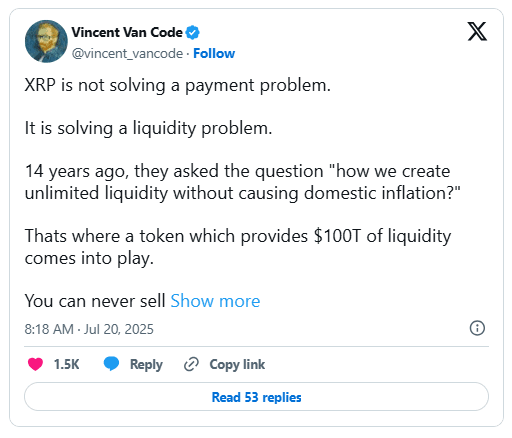Vincent Van Code, a respected software engineer and blockchain analyst, recently provided a prominent perspective on the true role of XRP in global finance. In a post on X, he argues that XRP does not solve payment issues. Instead, it addresses a much deeper challenge: liquidity.
According to Van Code, Ripple's founding vision, formed over 14 years ago, focused on an important question: "How do we create unlimited liquidity without causing domestic inflation?"
The answer is a digital asset that can facilitate instant cross-border value transfers without relying on national currencies or monetary expansion. He asserts that XRP was built to be that bridge, a final bridge that could allow over $100 trillion in liquidity to flow freely, without systemic risks of inflation or currency devaluation.
Importantly, this liquidity has never been about buying or selling $100 trillion worth of XRP. Instead, XRP serves as a temporary medium used to exchange value, particularly stablecoins, with accuracy according to the existing supply. Not faster, not slower. In this role, XRP becomes a kind of "hydraulic fluid" in the global economy, enabling seamless conversions between assets in a way that fiat currencies simply cannot.

XRP as a Liquidity Tool
This vision extends the utility of XRP far beyond the scope of payments. While many view Ripple's On-Demand Liquidity (ODL) system as a way to reduce fees and payment times for cross-border transactions, Van Code emphasizes a more fundamental point: XRP is addressing the liquidity bottlenecks that have long constrained the global financial system.
Through ODL, financial institutions do not need to pre-fund accounts in multiple currencies. Instead, they can create instant liquidity, using XRP to connect value between fiat money and stablecoins, such as RLUSD or EURØP, without going through intermediaries. This helps minimize friction, improve capital efficiency, and reduce exchange rate volatility risks.
Ripple's Stablecoin Integration
Ripple's recent push to develop stablecoins further reinforces XRP's role in this new liquidity architecture. The launch of RLUSD and the integration of EURØP backed by euros into the XRP Ledger have expanded Ripple's utility pool. These stablecoins complement XRP, allowing organizations to lock in fiat value while still relying on XRP for real-time payments.
Van Code emphasizes that the interaction between stablecoins and XRP creates a scalable system capable of replicating the liquidity depth of the global banking system without the need to inflate or manipulate the money supply. In this sense, XRP becomes a "connector," rather than a store of value.
XRP Price and Market Outlook
As of the time of reporting, XRP is trading at $3.53, with daily volatility ranging from $3.39 to $3.54. Although still below speculative peak levels, XRP is currently operating in a completely different context. Regulatory clarity, increased adoption, and the expansion of use cases for businesses have reinforced XRP's position as a utility asset.
Analysts expect Ripple's liquidity framework, especially its stablecoin strategy, to drive long-term value for XRP. With institutions increasingly adopting blockchain solutions, XRP may soon be recognized as a critical platform in the future of finance, rather than just a speculative token.
As Van Code succinctly put it: when you understand XRP's role in creating scalable and unobstructed liquidity, you will begin to see its true value.
